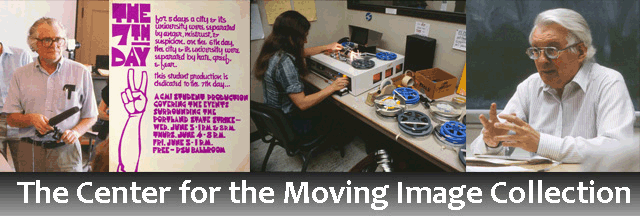Loading...
Document Type
Film
Publication Date
5-1972
Original Format
16mm film
Rights
This digital access copy is for educational use only. It cannot be copied, distributed or screened for commercial purposes. It is made accessible because of one or more of the following situations: the rights are owned by State Board of Higher Education, on behalf of Portland State University; Portland State University has permission to make it accessible; it is made accessible for education and research purposes under "fair use"; or there are no known restrictions on use. In the event that previously unknown information is shared that may change the status of this item, it will be immediately removed from public view until pertinent rights issues are clarified.
Contact Special Collections at Portland State University Library at: specialcollections@pdx.edu or (503) 725-9883
Abstract
In May 1972, Abstract Expressionist artist Helen Frankenthaler came to Portland as part of a "Visiting Artist Program" organized by the Art Department of Portland State University. The program brought the artist and nine of her paintings with the support of the Oregon Arts Commission, the Portland Art Museum, and the Academically Controlled Auxiliary Activities Committee at PSU.
At Portland Art Museum, the artist gave a slide show and preview of the selected work, which was installed in the sculpture garden of PAM. The following day, Frankenthaler participated in an informal Q & A session in PSU's Lincoln Hall Auditorium with area art students and members of the public.
The Q & A at the university was recorded by Ed Du Vivier and Mel Katz, with support from PSU's Television Services and with the assistance of Tom Taylor and the Center for Moving Image, with the idea that the recording, with funding and support from the Oregon Arts Commission, would later be made available to other schools, museums, and libraries.
In this restored version of the film, Frankenthaler discusses her work, her youthful influences, her association with the New York School of painting, and whether advanced formal training aids or hinders the artistic process.
Description
This film is available for viewing thanks to the coordinating efforts of Heather O. Petrocelli and the dedicated work of skilled film preservationists/digital film transfer specialists Gary Lacher and Kelley Baker.
Though the 16mm film itself was in good physical condition, the rolls that Lacher and Baker were working with were comprised of two "A" and "B" rolls of film, as well as a third separate roll of magnetic sound track (a common way to keep film for editing and making final prints).
Fortunately, Lacher, a veteran film editor and producer, had experience in combining all three rolls to make a finished product. He had spent the early part of his career in television editing, where at times all three rolls were run and synchronized live on-air, so he was undaunted by the fragmented state of the film.
Lacher was able to transfer all three rolls to digital format so that they could be edited digitally, and brought Baker on for the labor-intensive process of syncing and editing the rolls into a more complete product with sound matching the images.
As Baker explained, though the separate elements started out as film elements and ran at the same speed, the rolls and sound track did not run in sync and had to be matched by way of a far more manual method: Baker watched the film until he saw someone say something that could be more easily identified on the audio. He would watch an audience member ask a question and then listen to the audio track, comparing lip and facial movements in the picture to the words in the sound track to hopefully match the two together. Since the sound track did not run at the same speed as the picture rolls (according to Baker it drifted noticeably out of sync every 45 seconds), this was a laborious task that had to be repeated numerous times.
In addition, as Lacher noted, because the film appeared to have some missing scenes and required editing, it took special attention and skill to craft a version as complete and as close as possible to the original filmmakers' intended work.
[Research on the original film and the transfer process by Meg Langford.]
Persistent Identifier
http://archives.pdx.edu/ds/psu/10196
Recommended Citation
Portland State University, "Helen Frankenthaler at Portland State: Q & A" (1972). Selections from the Center for the Moving Image Film Collection. http://archives.pdx.edu/ds/psu/10196


